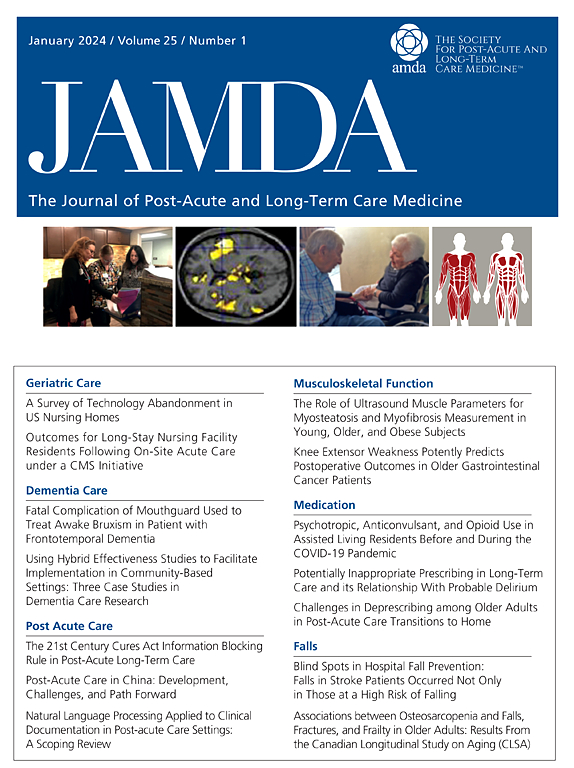解决方案,以改善国家健康结果和获得医疗保险受益人的护理:全面实践的APRNs
IF 4.2
2区 医学
Q2 GERIATRICS & GERONTOLOGY
Journal of the American Medical Directors Association
Pub Date : 2025-04-24
DOI:10.1016/j.jamda.2025.105585
引用次数: 0
摘要
目的了解高级执业注册护士(APRN)限制性执业法对在急症、初级、养老院(长期住院)和熟练护理机构(短期住院)提供服务的APRN数量的影响;了解限制实践与医疗保险受益服务数量之间的关系;了解《联邦报告》各州健康排名所显示的限制性做法与卫生保健总体质量之间的关系。design1个大型联邦数据集和2个包含2022年各州排名的国家年度报告被用于这项对比性描述性研究。环境和参与者我们根据国家实践限制(完全、减少或限制)和护理环境总结了服务数量× APRN × 1000例患者。我们评估了州际差异,并报告了在所有设置中表现明显高于或低于总体中位数的州。最后,我们拟合了一个线性回归模型来探讨服务数量× APRN × 1000受益人与联邦报告健康排名的关系。结果无论在何种护理环境下,全员执业状态下的aprns所提供的服务均明显多于减少或限制状态下的aprns。在调整实践限制和护理环境后,服务次数× APRN × 1000受益人与国家整体健康排名之间无显著相关性(回归系数β = 0.003, P = .736)。然而,实践限制被发现是非常重要的,充分实践状态表明整体健康状况更好(P <;.001),与设置无关。结论和意义发现联邦健康排名非常显著,充分实践状态表明整体健康状况较好,16至18个排名优于减少或限制实践(P = .001),在所有护理设置中保持一致。限制性执业法减少了获得保健的机会。现在是限制和减少实践的州重新审查其APRN实践法律的时候了,以使医疗保险受益人增加获得护理的机会,并改善整体健康结果。本文章由计算机程序翻译,如有差异,请以英文原文为准。
Solution to Improve State Health Outcomes and Access to Care for Medicare Beneficiaries: Full Practice of APRNs
Objective
To identify the influence of advanced practice registered nurse (APRN) restrictive practice laws on the number of APRNs providing services in various care settings, acute, primary, nursing home (long stay), and skilled nursing facility (short stay); understand the relationship between restrictive practice and number of Medicare beneficiary services across settings; and to understand the relationship between restrictive practice and overall quality of health care as indicated by Commonwealth Report state health rankings.
Design
One large federal data set and 2 national annual reports with state rankings from 2022 were used in this comparative, descriptive study.
Settings and Participants
We summarized number of services × APRN × 1000 patients by state practice restriction (full, reduced, or restricted) and setting of care.
Methods
We evaluated interstate variability and reported states that performed significantly above or below the overall median across all settings. Last, we fitted a linear regression model to explore the association of number of services × APRN × 1000 beneficiaries with Commonwealth Report health ranking.
Results
APRNs in full-practice states provide significantly more services than in reduced or restricted, regardless of care setting. After adjusting for practice restriction and care setting, no significant association was found between the number of services × APRN × 1000 beneficiaries and the state overall health ranking (regression coefficient β = 0.003, P = .736).
However, practice restriction was found to be highly significant, with full-practice states indicating overall better health (P < .001), regardless of setting.
Conclusions and Implications
Commonwealth Health ranking was found to be highly significant, with full-practice states indicating overall better health, 16 to 18 rankings better than reduced or restricted practice (P = .001), remaining consistent across all settings of care. Restrictive practice laws reduce access to care. It is time states with restrictive and reduced practice reexamine their APRN practice laws to enable Medicare beneficiaries increased access to care and improve overall health outcomes.
求助全文
通过发布文献求助,成功后即可免费获取论文全文。
去求助
来源期刊
CiteScore
11.10
自引率
6.60%
发文量
472
审稿时长
44 days
期刊介绍:
JAMDA, the official journal of AMDA - The Society for Post-Acute and Long-Term Care Medicine, is a leading peer-reviewed publication that offers practical information and research geared towards healthcare professionals in the post-acute and long-term care fields. It is also a valuable resource for policy-makers, organizational leaders, educators, and advocates.
The journal provides essential information for various healthcare professionals such as medical directors, attending physicians, nurses, consultant pharmacists, geriatric psychiatrists, nurse practitioners, physician assistants, physical and occupational therapists, social workers, and others involved in providing, overseeing, and promoting quality

 求助内容:
求助内容: 应助结果提醒方式:
应助结果提醒方式:


